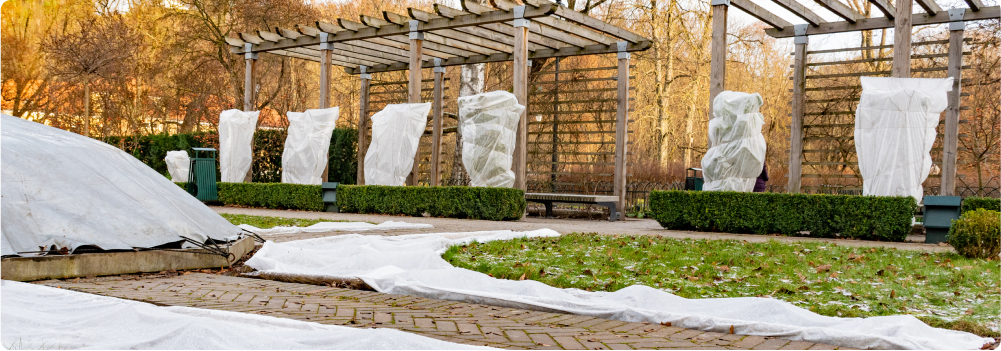The right plan for your home, right here.
Coverage options built for every home and budget.


Don’t let your plants get left in the cold—literally. Protecting plants from frost will help keep all of your greenery safe all year long. Learn how to protect plants from frost with this helpful, how-to guide.
It might feel like summer was just yesterday when the first frost hits. Before autumn gets into full swing and overnight temps dip below freezing, it’s a good idea to take steps to prepare your plants. Understanding how to prevent frost on plants can save your precious greenery and safeguard your wallet.
Homeowners may have a tendency to prioritize vegetable gardens and forget about their landscaping plants. But these overlooked plants are just as vulnerable, as frost damage can cause plants to wilt or even die, leaving your garden - and your wallet - in the cold. Landscaping plants likely represent a large chunk of your greenery investment, adding to the curb appeal of your home—so keeping these beauties alive is essential!
Understanding which plants in your garden require protection, and which can handle the elements, is key to protecting plants from frost. Here are some examples of frost-vulnerable plants:
Get to know your garden and the plants that need extra protection as the temperatures dip. To find out which plants in your garden are hardy enough to withstand frost, use the USDA Plant Hardiness Zone Map here.

Keeping your plants safe from a cold snap takes a little bit of planning, but the effort goes a long way. And understanding how to prevent frost on plants is essential for a thriving, year-round garden.
So, what should you cover your plants with to protect from frost? Here are some simple, cost-effective strategies that can help keep your greenery safe.
When it comes to figuring out how to protect plants from frost, covering your plants is one of the easiest ways to protect them. Use common household materials to insulate plants and keep them warm overnight:
For larger plants, creating makeshift structures can be a quick, DIY solution:
If you have potted plants that are sensitive to frost, the best solution is to bring them indoors during cold nights. Moving them into a garage, basement, or even a sunroom can help protect them from frost damage.
Mulching around the base of your plants helps insulate the soil and retain heat. Use organic materials like pine straw, bark, or wood chips to protect the roots of your plants from freezing temperatures. Mulching also helps conserve moisture and prevents winter soil erosion.
Thinking about coverage?
Security for your home. Protection for your budget.
Sometimes life happens. If frost sneaks up on you faster than you can prepare for it, there are steps you can take to mitigate the damage. Here’s how to protect plants from freezing weather, even after the fact.
If frost does damage your plants, wait until the cold snap is over before you prune them. Cutting back damaged branches and stems to the point of new growth will help the plant recover. Resist the urge to prune too early, as late frost could still cause damage.
For a more permanent solution, consider planting cold-hardy varieties that can withstand winter weather. Luckily, nature has gifted us with many frost tolerant plants that do well in colder climates. Look for varieties like:
Adding more of these to your plant collection means less maintenance for you, while still maintaining a beautiful yard.
Protecting plants from frost is a part of gardening life, but it doesn’t have to make your life hard. When it comes to learning how to prevent frost on plants, simple covers, insulating with mulch, or choosing cold-hardy varieties will protect your precious plants for a happy, healthy garden.
By taking the steps above, you’ll ensure your plants stay healthy and vibrant all winter long, just as American Home Shield® helps keep your home running smoothly all year round. Explore our home warranty plans today and breathe a sigh of relief knowing your covered items are protected.
Not sure what a home warranty is? No worries! Check out our FAQs or contact us to learn more.
Coverage options built for every home and budget.

AHS assumes no responsibility, and specifically disclaims all liability, for your use of any and all information contained herein.
Have a plan for your home when things don't go according to plan
Shop Home Warranties